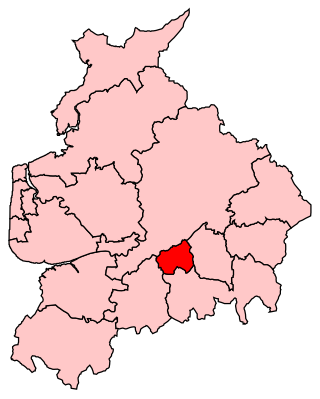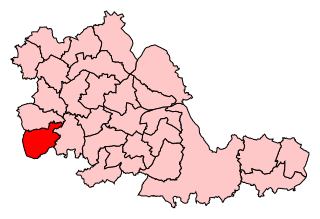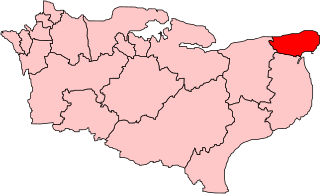Related Research Articles

Blackburn is a constituency in Lancashire, England, which has been represented in the House of Commons of the UK Parliament since 2015 by Kate Hollern of the Labour Party. From 1979 to 2015, it was represented by Jack Straw who served under the Labour leaders of Neil Kinnock and John Smith and the Labour governments of Tony Blair and Gordon Brown.

Preston is a constituency represented in the House of Commons of the UK Parliament since 2000 by Sir Mark Hendrick, a member of the Labour Party and Co-operative Party.

Stourbridge is a constituency in West Midlands represented in the House of Commons of the UK Parliament since 2019 by Suzanne Webb, a member of the Conservative Party. The seat was previously held by Margot James, a Conservative who lost the whip in September and October 2019 and did not run for re-election.
Grantham was a Parliamentary constituency in Lincolnshire, England.
Dulwich was a borough constituency in the Dulwich area of South London, which returned one Member of Parliament (MP) to the House of Commons of the Parliament of the United Kingdom.

Ilkeston is a former United Kingdom Parliamentary constituency. It was a constituency of the House of Commons of the Parliament of the United Kingdom. It was represented by one Member of Parliament. In 1983 it was abolished, together with South East Derbyshire, when the Derbyshire county constituencies were redrawn - the constituencies of Amber Valley and Erewash were created and the constituency of South Derbyshire was re-created.
Shrewsbury was a parliamentary constituency in England, centred on the town of Shrewsbury in Shropshire.

Isle of Thanet was a county constituency which returned one Member of Parliament (MP) to the House of Commons of the Parliament of the United Kingdom from 1885, until it was abolished for the February 1974 general election.
Walsall was a borough constituency centred on the town of Walsall in the West Midlands of England. It returned one Member of Parliament (MP) to the House of Commons of the Parliament of the United Kingdom, elected by the first past the post voting system.
Leek was a parliamentary constituency in Staffordshire which returned one Member of Parliament (MP) to the House of Commons of the Parliament of the United Kingdom.
Tonbridge was a parliamentary constituency in Kent, centred on the town of Tonbridge. It returned one Member of Parliament (MP) to the House of Commons of the Parliament of the United Kingdom.
Birmingham Handsworth was a parliamentary constituency centred on the Handsworth district of Birmingham. It returned one Member of Parliament (MP) to the House of Commons of the Parliament of the United Kingdom. It was abolished in 1983.
Leeds North was a borough constituency in the city of Leeds, West Yorkshire, which returned one Member of Parliament (MP) to the House of Commons of the Parliament of the United Kingdom, elected by the first past the post voting system.
Islington West was a borough constituency in the Metropolitan Borough of Islington, in North London.
West Bromwich was a borough constituency represented in the House of Commons of the Parliament of the United Kingdom from 1885 until 1974. It centred on West Bromwich, in the West Midlands. It elected one Member of Parliament (MP) by the first past the post voting system.
Brierley Hill parliamentary constituency was located in the West Midlands of England. It returned one Member of Parliament (MP) to the House of Commons of the Parliament of the United Kingdom, elected by the first past the post system.
Dudley was a parliamentary constituency centred on the town of Dudley in Worcestershire which existed between 1832 and 1974. It returned one Member of Parliament (MP) to the House of Commons of the Parliament of the United Kingdom, elected by the first past the post system.
Wembley South was a constituency in what was then the Borough of Wembley in Middlesex and from 1965 wholly in northwest London. It returned one member (MP) to the House of Commons of the UK Parliament, elected by the first past the post system, returning Conservative apart from in 1945, the victory of the First Attlee ministry when it returned a Labour member.
Sir Ralph Kilner Brown, OBE, TD, DL, was a British hurdling athlete, Liberal Party politician and judge.
Hanley was a borough constituency in Staffordshire which returned one Member of Parliament (MP) to the House of Commons of the Parliament of the United Kingdom between 1885 and 1950. Elections were held using the first past the post voting system.
References
- 1 2 "Prospects of Mr. Moyle" . The Birmingham Mail . No. 26, 702. 18 October 1951. p. 7. Retrieved 4 January 2024– via British Newspaper Archive.
- ↑ British parliamentary election results, 1950-1973 by FWS Craig
- ↑ "Mr. Eden: "I have no conjuring trick" - Housewives' cheers" . The Birmingham Post . No. 29, 077 (City ed.). 23 October 1951. p. 5. Retrieved 4 January 2024– via British Newspaper Archive.
- ↑ British parliamentary election results, 1950-1973 by FWS Craig
- ↑ British parliamentary election results, 1950-1973 by FWS Craig
- ↑ "Candidate for Oldbury" . Birmingham Post . No. 30, 888 (County ed.). 24 August 1957. p. 5. Retrieved 4 January 2024– via British Newspaper Archive.
- ↑ F W S Craig, British Parliamentary Election Results 1950-1973; Political Reference Publications, Glasgow 1973
- ↑ Bolter, Harold (5 October 1964). "Oldbury and Halesowen: Green hills, black towns" . Birmingham Post . No. 33, 055 (County ed.). p. 10. Retrieved 3 January 2024– via British Newspaper Archive.
- ↑ F W S Craig, British Parliamentary Election Results 1950-1973; Political Reference Publications, Glasgow 1973
- ↑ Deacon, Colin (30 March 1966). "Oldbury and Halesowen: Liberal vote a major factor but not vital" . Birmingham Post . No. 33, 514 (County ed.). p. 6. Retrieved 4 January 2024– via British Newspaper Archive.
- ↑ British parliamentary election results, 1950-1973 by FWS Craig
- ↑ "Marplan: Midland marginal could go to Tories for the first time" . Birmingham Post . No. 31, 815 (6 a.m. ed.). 10 June 1970. p. front. Retrieved 4 January 2024– via British Newspaper Archive.
- ↑ British parliamentary election results, 1950-1973 by FWS Craig